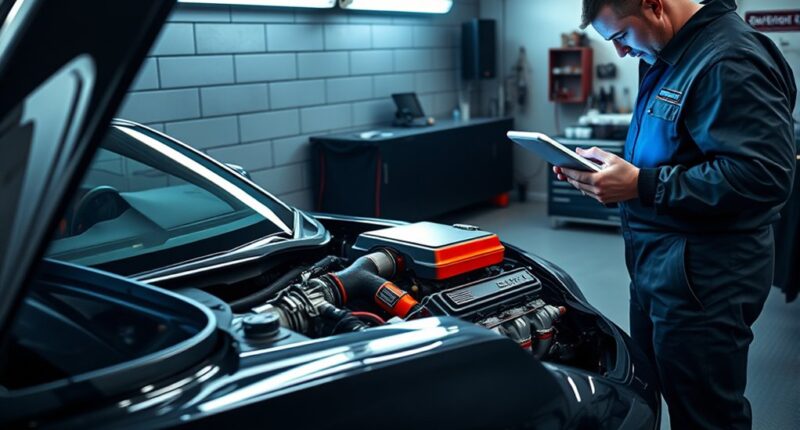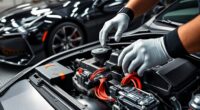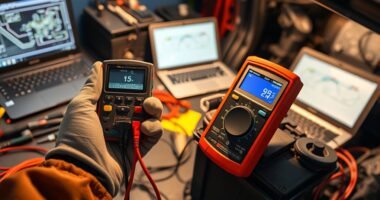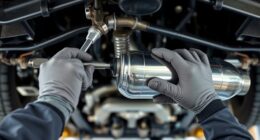When tuning your car, common issues include fuel delivery problems, ignition misfires, and ECU misalignment. Upgrading fuel pumps, injectors, and ignition components helps prevent knock and misfires. Ensuring proper ECU calibration and synchronization avoids drivability issues. High boost pressures can stress engine parts, so regular maintenance and quality upgrades are essential. By addressing these areas now, you can improve reliability and maximize performance — and there’s more to uncover that can keep your car running smooth.
Key Takeaways
- Fuel delivery issues like lean conditions or pressure drops can cause misfires; upgrade pumps and injectors to fix them.
- Ignition problems such as misfires or coil failures are common; replace worn plugs and upgrade coils for reliability.
- ECU synchronization errors lead to poor engine performance; ensure proper sensor calibration and software updates.
- Overboost and high cylinder pressures increase mechanical stress; use proper tuning and cooling upgrades to prevent engine damage.
- Routine maintenance, diagnostics, and inspecting turbo components help identify issues early and maintain tuned car performance.
Fuel System Limitations and Solutions

When tuning a car for higher performance, fuel system limitations often become a critical bottleneck. You’ll face octane restrictions that cap boost and power to prevent pre-ignition on pump gas. Stock fuel injectors may lack the flow needed for increased air from turbo upgrades, risking lean conditions at high RPM. Fuel pumps can struggle to maintain pressure under boost, causing pressure drops and risking damage. Fuel system constraints are a primary factor in power ceilings on pump gas. Cylinder pressure and temperature thresholds also restrict safe power increases without causing detonation. Your factory ECU mightn’t adjust properly for upgraded components, leading to fueling issues. Upgrading to high-flow fuel pumps, larger injectors, and installing fuel pressure regulators can help address these issues. Methanol injection and flex-fuel kits further enhance delivery and resistance to knock, boosting reliability and performance. Additionally, understanding fuel system limitations can help optimize tuning strategies for maximum safe power gains. Implementing performance fuel management solutions ensures consistent fueling under increased boost and power demands.
Ignition System Troubleshooting and Repairs

Tuning a car for increased performance puts added stress on the ignition system, making troubleshooting and repairs more important than ever. Common issues include misfires under boost caused by worn spark plugs, excessive gaps, or faulty coils unable to deliver enough voltage. Overheating coils or corroded distributor contacts also disrupt spark delivery. Use diagnostic tools like OBD-II scanners, spark testers, and voltage drop tests to pinpoint faults quickly. Upgrading components such as high-energy coils, iridium plugs, and insulated wires enhances reliability. Regular maintenance, including gap checks, moisture prevention, and resistance testing, keeps your ignition system in top shape during aggressive tuning. Proper ignition system maintenance is essential to prevent damage and ensure consistent engine performance. Additionally, monitoring system voltage stability helps identify potential issues before they lead to failures. Maintaining a diversification strategy in your tuning approach can help mitigate unforeseen problems and extend engine life. Here’s a quick overview:
| Issue | Cause | Solution |
|---|---|---|
| Misfire under boost | Worn spark plugs, faulty coil | Replace plugs, upgrade coil |
| Intermittent misfire | Corroded contacts, damaged wires | Clean/replace contacts, inspect wires |
| Spark weakness | Overheating coils, incorrect gap | Upgrade cooling, adjust gap |
Addressing ECU Synchronization Problems
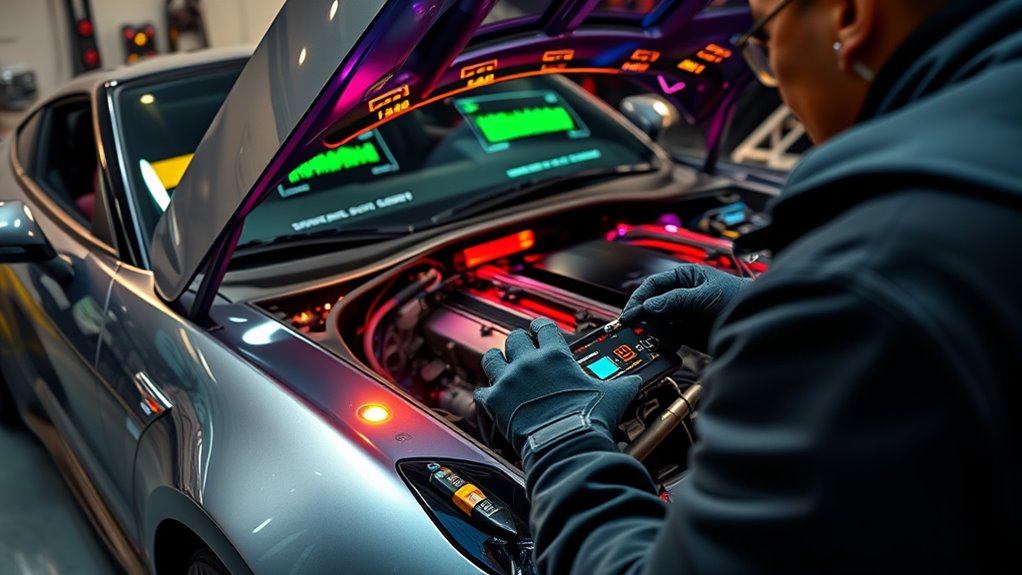
Addressing ECU synchronization problems is essential for maintaining peak engine performance and reliability, especially in modified or high-performance setups. Incorrect synchronization can cause poor fuel injection, misfires, or even engine failure. Using essential oils such as eucalyptus oil for its decongestant qualities is unrelated but highlights the importance of proper maintenance and health, paralleling the need for precise calibration in engine systems. To diagnose these issues, use ref/sync capture tools to analyze signal alignment and identify misfires or missing signals. Check sensor connections, wiring, and ensure the sensors are correctly calibrated and positioned. Verify the trigger wheel’s alignment and the air gap between the sensor and the wheel, as improper gaps can disrupt signals. Adjust the sensor placement, repair wiring faults, or realign the trigger wheel as needed. Additionally, update the ECU software and verify settings to match your engine modifications. Regular maintenance prevents synchronization issues from developing, ensuring consistent engine operation. Incorporating advanced sound analysis techniques can also help in identifying subtle irregularities in engine performance that may be linked to synchronization problems.
Managing Risks of Forced Induction Stress
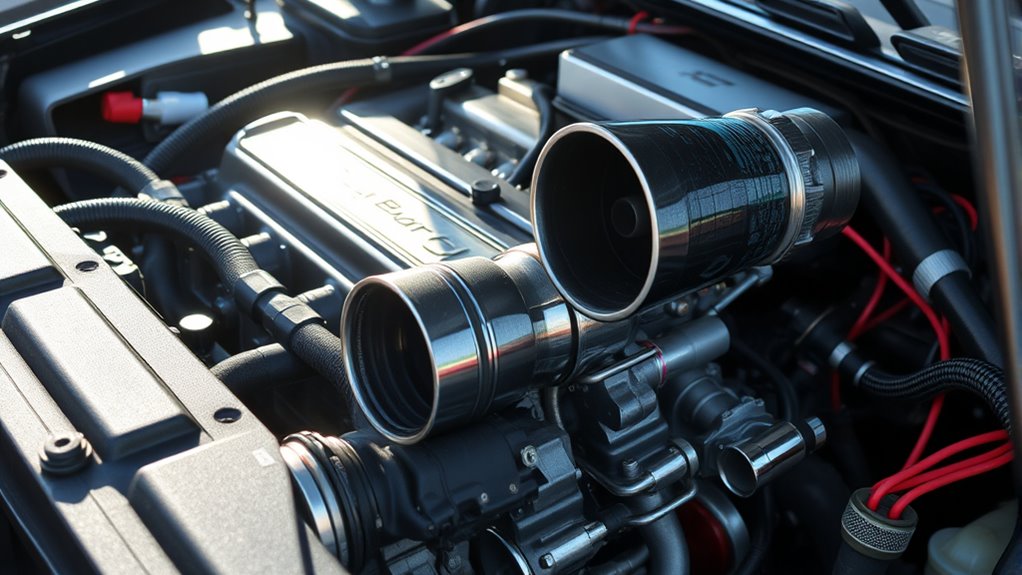
Managing the additional stresses that forced induction places on your engine is *essential* for maintaining reliability and longevity. High combustion pressures increase strain on pistons, rings, and connecting rods, risking premature wear or failure. Elevated engine temperatures can cause overheating if cooling systems aren’t upgraded or properly monitored. It’s *fundamental* to keep exhaust gas temperatures in check and invest in better cooling solutions to prevent engine damage. Proper tuning and system calibration are crucial to ensure safe operation and performance. Properly managing fuel and air ratios is also *indispensable*; improper tuning can lead to knocking or inefficient combustion, accelerating component wear. Regular maintenance, including monitoring engine temperatures and inspecting gaskets and seals, helps mitigate risks. Ensuring your drivetrain can handle increased torque is equally important. Proper management of these stress factors keeps your engine reliable and extends its lifespan amid higher power demands. Additionally, understanding how high-pressure systems impact engine components can help in selecting appropriate upgrades and maintenance routines. Utilizing quality aftermarket parts designed for high-stress conditions can further enhance durability and performance.
Identifying and Fixing Component Failures

Identifying and fixing component failures is essential to maintaining the reliability of your tuned car. First, check the ignition system: look for misfires under boost, erratic timing, coil overheating, spark plug gaps, and grounding issues. Proper ignition timing and reliable spark delivery are critical for optimal engine performance and avoiding damage. Second, inspect the fuel system: verify voltage at the pump, ensure injectors aren’t maxed out, and test fuel pressure and lines for leaks or degradation. A well-maintained fuel system ensures consistent delivery and prevents lean or rich conditions that can harm the engine. Third, examine sensors and electrical connections: confirm crank/cam signals are steady, clean MAF sensors, and ensure proper grounding to prevent interference. Additionally, sensor calibration plays a vital role in accurate data reporting and engine management. Regularly inspecting and maintaining these components can prevent common issues associated with tuning modifications, especially in models with ECU tuning options. Proper maintenance of performance parts and staying within recommended specifications can further enhance reliability.
Post-Tune Maintenance Practices
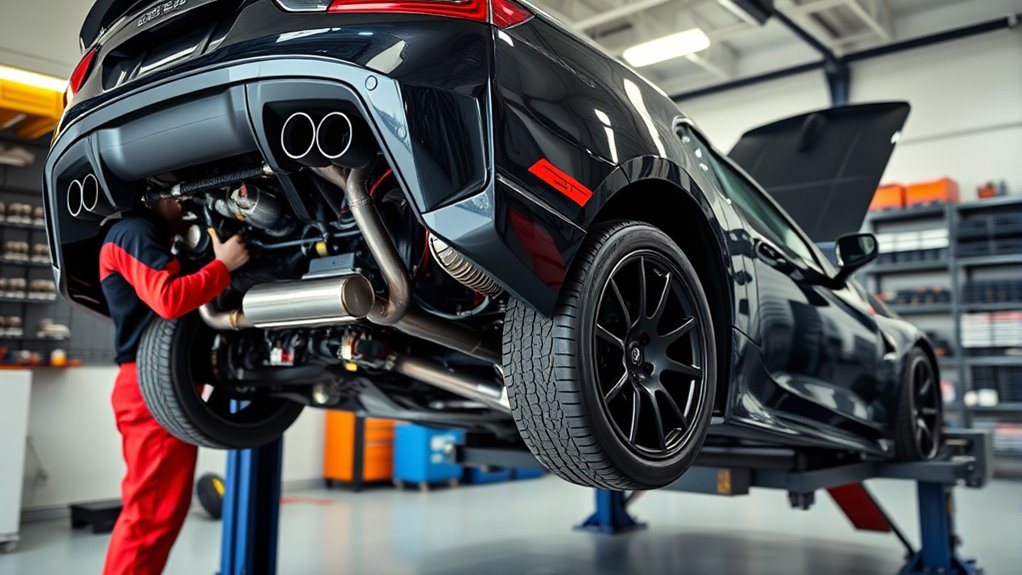
After tuning your car, establishing a routine of post-tune maintenance is essential to keep it running at peak performance. Regular checkups, like fault code scans, help catch issues early. Routine maintenance helps prevent minor problems from developing into major repairs, saving time and money in the long run. Keep an eye on oil condition, using the correct grade and additives, and perform visual inspections for wear or leaks. Schedule consistent service appointments and monitor performance to spot deviations quickly. Maintain the cooling system by ensuring proper coolant levels, clean air filters, and functioning fans and sensors. Regularly inspect the exhaust system for leaks and keep fuel quality high, replacing filters as needed. Update the ECU software and calibrate sensors to prevent management issues. Finally, check suspension, brakes, and tire pressure regularly to maintain handling and safety. Consistent maintenance ensures your tuned car remains reliable and performs excellently.
Diagnosing and Preventing Overboost Conditions
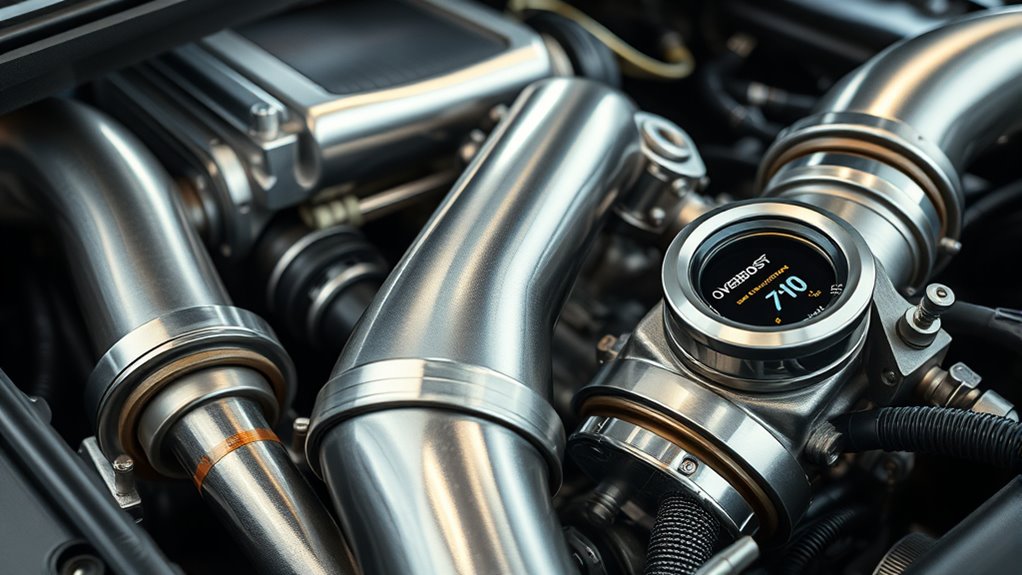
Overboost conditions can cause serious damage to your turbocharged engine if not diagnosed and prevented promptly. To identify issues early, you should focus on three key areas.
- Use a scan tool to check for fault codes like P0234 and monitor live boost pressure data.
- Test the wastegate actuator with compressed air to ensure proper movement and vacuum integrity.
- Validate boost pressure sensor readings with a multimeter or by replacing the sensor if readings seem off.
Additionally, perform smoke tests to find vacuum leaks and inspect the turbo for vane function, shaft play, or foreign objects. Incorrect remap settings can also contribute to overboost issues, especially if the ECU tuning was not done professionally. Regularly monitoring boost behavior allows you to catch developing problems before they cause costly damage. Proper diagnosis and preventive measures keep your turbo system running smoothly and safely.
Ensuring Compatibility and Proper Calibration
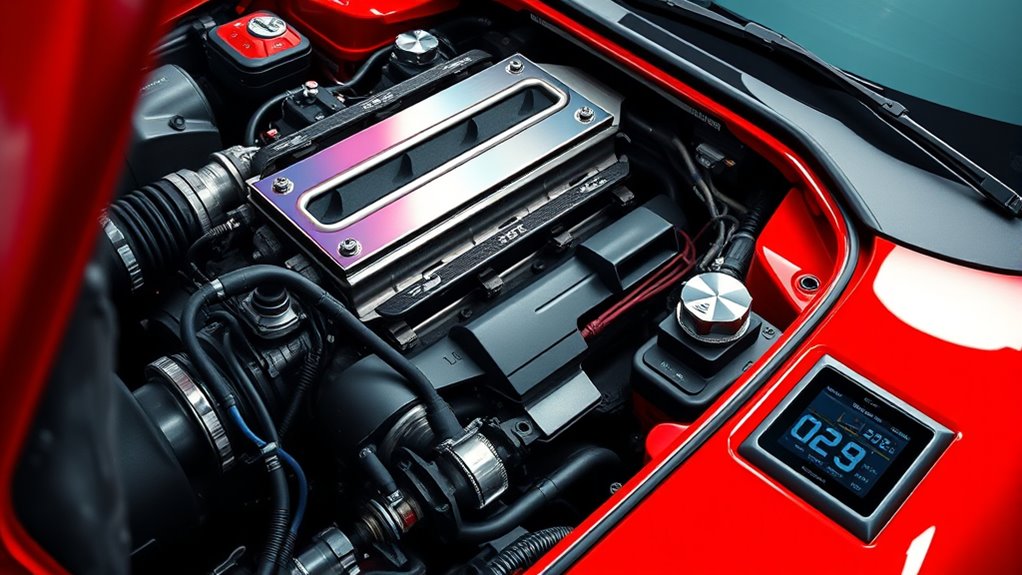
Ensuring compatibility and proper calibration is essential when upgrading your car’s ECU or hardware components. You need to match ECU tuning to your specific upgrades, like intake, exhaust, or turbo, to prevent drivability issues and stress on parts. Using generic tunes without considering installed hardware can cause poor performance and transmission problems. Experience shows that mismatched calibrations can lead to engine damage and reduced reliability. Make sure sensors—fuel pressure, boost, intake air temperature—are compatible and correctly referenced. Proper calibration involves setting accurate air-fuel ratios, ignition timing, and fuel pressure based on your hardware and environment. Confirm sensor types, wiring integrity, and that hardware modifications are fully supported. After tuning, verify fuel pressure, log data during driving, and test for drivability issues. Correct calibration and compatibility checks help avoid engine knocking, poor efficiency, and shifting problems.
Frequently Asked Questions
How Can I Tell if My Fuel Pump Is Undersized for Tuning?
To tell if your fuel pump is undersized for tuning, pay attention to engine performance. If you notice sputtering, misfires, or hesitation during acceleration, your pump might be struggling.
Listen for whining noises, check fuel pressure with a gauge, and watch for engine stalling or a check engine light.
Increased cranking time and poor fuel economy are also signs. If these occur, upgrading your pump could improve performance.
What Are Signs of Ignition Coil Failure After Modifications?
Think of your engine like a symphony—when an ignition coil fails, it’s like a musician missing a beat. You might notice misfiring, rough idling, or reduced power after modifications.
An illuminated check engine light or difficulty starting can also signal trouble. Keep an eye on these signs, and consider professional diagnostics to catch issues early.
Regular maintenance and using quality parts help prevent coil failure and keep your tune running smoothly.
How Do I Verify ECU Trigger Wheel Calibration Accuracy?
To verify your ECU trigger wheel calibration accuracy, start by checking the timing signals with your software, guaranteeing they match the expected pattern.
Confirm the trigger wheel is properly aligned with the sensor, and adjust the timing lock and offset as needed.
Run the engine through different RPM ranges, and recheck signals to ensure consistency.
If signals are off, re-align or recalibrate until the timing signals are accurate and stable.
What Precautions Prevent Turbocharger Damage During High Boost?
Did you know turbochargers rotate at up to 200,000 RPM? To prevent damage during high boost, you need to stay within manufacturer limits.
Use a boost gauge to monitor pressure, and avoid exceeding recommended levels. Regularly inspect your system for leaks, maintain proper oil supply, and make certain your blow-off valve functions correctly.
These steps protect your turbo from stress, prolonging its life and keeping your car running smoothly.
How Often Should I Inspect for Boost Leaks Post-Tuning?
You should inspect for boost leaks regularly after tuning, ideally every 5,000 miles or following significant modifications.
Keep an eye on performance changes like reduced power or fuel efficiency, and listen for hissing sounds during acceleration.
Conduct visual checks of hoses and clamps, and use a boost leak tester to pressurize the system.
Consistent inspections help catch leaks early, ensuring your turbo runs smoothly and maintains peak performance.
Conclusion
Tuning your car can boost performance, but it’s essential to address common issues like fuel limits and ignition troubles. Did you know that improperly tuned engines can reduce lifespan by up to 20%? Regular maintenance and proper calibration help prevent problems and keep your ride running smoothly. Stay vigilant, follow best practices, and enjoy the thrill of a finely tuned car without risking costly repairs or damage. Keep these tips in mind for a safer, more reliable experience on the road.
